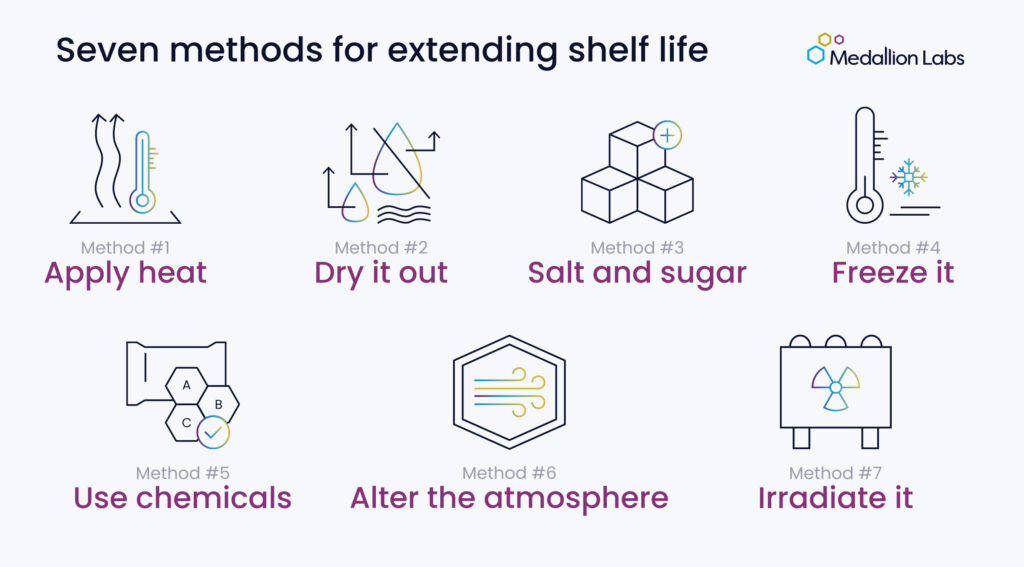Everything food producers & brands need to know about shelf life

You’ve done it—you found the right ingredients, perfected your recipe, secured funding, and developed a brand for your food product. It’s ready to hit the shelves.
Except there’s one thing missing—the shelf life.
But how do you determine shelf life?
What factors influence shelf life, and how can you extend it?
If you’re wondering about the answers, then hang on and don’t worry. We answer each question in the paragraphs below.
So read on to find out everything you need to know about shelf life and take the next step toward getting your food product on the shelves and into the carts of willing customers.
What do we mean by “shelf life” versus “expiration date” and “best by date”?
While these terms relate to each other, they all come with a unique definition. And for food manufacturers, it pays to know the differences.
We can define “shelf life” as the amount of time a specific food or beverage retains a level of quality and safety that makes it fit for consumption.
You can also define shelf life as the time between when you produce an item and when it becomes no longer safe to eat or drink.
In either case, you get the same thing—shelf life determines how long an item can remain on (you guessed it) the shelf before needing to be sold or disposed of.
Other essential terms related to shelf life include “expiration date” and “best-by date.”
Food producers print an expiration date on perishable items that pose a biological risk to humans after a specific time, such as meat and cheese. Consuming an item after the expiration date can lead to food poisoning.
The expiration date depends mainly on factors such as how an item is stored, moisture levels within the food, the presence of microbes, and oxidation.
Best-by dates apply more to stable, durable products and mark when a product loses its desirable physical traits.
The smell, color, taste, or texture might all degrade following the best-by date; however, an individual could still safely consume the item without risk of food poisoning.
Many food producers fortify their foods with antioxidants to help delay the best-by date of their products.
What factors impact the shelf life of a food product?
When it comes to determining the shelf life of a food product, several factors contribute to deterioration and loss in quality; however, each factor falls into two main categories: intrinsic (which are factors inherent to the food itself) and extrinsic (which are external conditions that the food faces).
Different quality parameters determine intrinsic and extrinsic factors, including nutritional, hygienic, chemical, physical, organoleptic (sensory factors such as appearance, mouth feel, aroma, and taste), and microbiological.
How a food product is cooked, fermented, or formulated determines the intrinsic factors that influence shelf life. To get the shelf-life correct (and protect both customers and brand image), food producers need to have an inherent understanding of the following intrinsic factors:
- Oxidation potential and available oxygen
- Raw materials
- Moisture levels
- Composition and formulation of the product (additives used)
- Nutrient content
- Water activity
- Total acidity and pH
- Sugar levels
- Levels of salt
- Potential Redox
- Antioxidant levels
The packaging and storage of food products determine the extrinsic factors that influence shelf life. These extrinsic factors include:
- The passage of time
- Exposure to sunlight
- Processing methods
- Damage to packaging
- Temperature
- Chemical preservatives
- Humidity
- Distribution and environment where the product is sold
How can producers extend the shelf life of a food product?
The answer depends on the food itself and how it’s processed. The good news is that food producers have several ways to extend shelf life.

Method #1 – Apply heat
Humans have been using this method of preserving food since the advent of cooking. Since microorganisms die off at higher temperatures, food producers can heat their products to make them longer-lasting, sterile, shelf-stable, and safe for human consumption. Heating food products works exceptionally well for sauces, jellies, jams, and syrups.
Method #2 – Dry it out
The microorganisms that cause trouble for consumers need water to thrive and reproduce. For this reason, drying food products increases shelf life by a drastic amount.
Method #3 – Salt and sugar
Beyond improving flavor, both salt and sugar play essential roles in extending the shelf life of food products. Sugar and salt extend shelf life by trapping free water, which limits and stops microbial growth. Because sugar and salt absorb water so effectively, products like jams, beef jerky, and butter do not require refrigeration.
Method #4 – Freeze it
Freezing foods stops harmful microorganisms from taking hold. And when food is frozen and kept below 0°F, the cold can kill microorganisms. Freezing a product also does an exceptional job of preserving its nutrient contents, especially with fruits and veggies.
Method #5 – Use chemicals
Chemicals such as antioxidants and oxygen absorbers help extend the shelf life of food products, especially when used in conjunction with other methods. These chemicals can be added directly to food, between the packaging and the food, or within the packaging but in separate containers or pouches.
Method #6 – Alter the atmosphere
The presence of oxygen and the process of oxidation can ruin products and limit their shelf life. Even a tiny amount of oxygen in a package can affect food this way. But “Modified Atmosphere Packaging” (MAP) can provide a solution. MAP introduces a mixture of gases other than air into food packages and eliminates the threat of oxidation. Vacuum packaging also falls into this category.
Method #7 – Irradiate it
Out of all the methods used to preserve food, this one is likely to come off as the most extreme, but it is effective. Irradiating food involves exposing food products to ionized radiation, killing microorganisms and insects. Irradiation increases shelf life and improves food safety.
How can food producers accurately determine shelf life?
Misjudge the shelf life of your product, and you risk diminishing its quality, putting customers at risk, angering retailers, and threatening your brand's reputation.
Avoiding these adverse outcomes requires a testing method that accurately determines shelf life.
Luckily, you have several testing options, which we listed below.
The direct method
The direct method of determining shelf life involves storing food products under environmental conditions that mirror those faced while in storage and on the shelf.
These studies involve close monitoring at regular intervals across real-time. While this method involves months of observation, it has the advantage of producing highly accurate estimations of shelf life.
If you’re interested in learning more about direct methods of determining shelf life, the experts at Medallion Labs are on hand to answer your questions.
They’re also happy to help you find a testing method that would work best for you, your product, and your budget. Click here to contact our experts or learn more about testing options with Medallion Labs.
Accelerated shelf life tests
Accelerated shelf life tests involve manipulating oxygen pressure, temperature, moisture levels, and other conditions to accelerate spoilage.
When it comes to finding affordable options for accelerated shelf life testing, look no further than Medallion Labs.
Their real-time simulations speed up the aging process and help food manufacturers accurately determine shelf life without breaking their budget.
Contact our experts today to learn more.
Predictive microbiology
Unlike other models that test physical products under natural conditions, this method uses statistical models to determine how microorganisms respond to food products under various circumstances.
Food manufacturers often utilize this method while developing new products; however, this process involves more complexity and more room for inaccuracy because it relies on theory rather than real-life observation.
Since accurate estimates of shelf life play an essential role in protecting products, reputations, and consumers, you want to reduce the margin of error as much as possible. That’s where Medallion Labs can offer extra peace of mind.
Their real-life simulations provide highly accurate shelf life predictions so that you can spend more time building your business and less time worrying about shelf life.
Survival method
Unlike other methods used in the lab, this method relies on customers' opinions of the physical characteristics of the products under examination.
This type of study seeks to understand how likely customers would be to consume the same product manufactured on different dates. The survival method works well for understanding how the shelf life relates to customers’ perceptions of the product in question.
While this method can’t be used to determine shelf life, it helps producers establish best-by dates that more accurately align with customer preferences.
Challenge Test
With the challenge test, scientists study how microorganisms introduced during production impact products under real-life conditions.
Although these tests can produce valuable information, they focus only on the effect of the introduced microbes rather than factoring in other conditions, such as temperature, moisture, and other environmental changes. Plus, these complex tests often prove challenging to conduct.
What’s the easiest way to determine shelf life?
Leave it to the experts at Medallion Labs. Their ambient and accelerated testing methods provide clear, accurate estimations of shelf life without costing a fortune.
Whether you need to determine how your product reacts to heat while in transit or how it responds to moisture levels in varying climates, Medallion Labs offers several affordable solutions.
That’s why brands like General Mills, Sunsweet, and AGT Foods trust Medallion Labs to handle their testing needs.
Take the next step and discover how Medallion Labs can help you determine shelf life and get your products on the shelves with confidence.
Let's Get to Work!
Submit your order online and ship your samples today. If you have questions, we are always here to help.
Medallion Labs+
A food testing program designed with mid-market and enterprise food and ingredient manufacturers in mind.